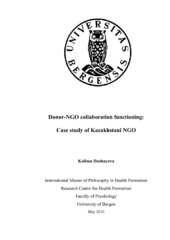| dc.contributor.author | Dosbayeva, Kalissa | |
| dc.date.accessioned | 2011-01-21T14:38:22Z | |
| dc.date.available | 2011-01-21T14:38:22Z | |
| dc.date.issued | 2010-05-21 | eng |
| dc.identifier.uri | https://hdl.handle.net/1956/4450 | |
| dc.description.abstract | The purpose of this study is to increase the knowledge base on the collaboration functioning by using a model developed by Corbin (2006), The Bergen Model of Collaborative Functioning. The research applied a case study design. Main data were obtained from semi-structured in-depth interviews with five informants from a Kazakhstani NGO Aman-Saulyk that engaged in health promotion practice. Aman-Saulyk collaborates with Soros Foundation Kazakhstan. The results show that collaboration is successful. Input interaction, leadership, negotiation, well established communication, structures and clear roles create positive loops of interaction. Negative loops of interaction represented by communication and structure. The Mission was found to be a base for collaboration functioning. External factors such as economical and/or political situation in the country have strong influence on collaboration functioning. The Bergen Model of Collaborative Functioning is proved as a pragmatic framework and a guide for analysis of this partnership. | en_US |
| dc.language.iso | eng | eng |
| dc.publisher | The University of Bergen | eng |
| dc.subject | Donor-NGO partnership | eng |
| dc.subject | Collaboration | eng |
| dc.subject | Synergy | eng |
| dc.subject | Environment | eng |
| dc.title | Donor-NGO collaboration functioning: Case study of Kazakhstani NGO | eng |
| dc.type | Master thesis | |
| dc.rights.holder | Copyright the author. All rights reserved | |
| dc.rights.holder | The author | eng |
| dc.description.degree | Master of Philosophy in Health Promotion | |
| dc.description.localcode | PSHE390T | |
| dc.description.localcode | MPHEPRO | |
| dc.subject.nus | 769909 | eng |
| dc.subject.nsi | VDP::Medisinske Fag: 700::Helsefag: 800 | nob |
| fs.subjectcode | PSHE390T | |
